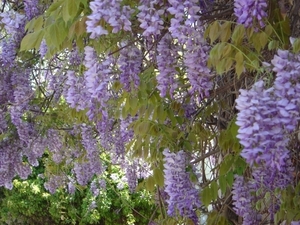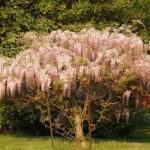Growing Wisteria Vine from seeds can be done, but you must have a lot of patience. It could take anywhere from 10 to 15 years for flowers to bloom. Gardener’s have many choices when it comes to picking out Wisteria Vine Seeds for planting. A Wisteria Vine is a fast growing, strong woody climbing vine that can grow over 30 feet. In the spring, the Wisteria Vines have beautiful trailing clusters of blue, pink, violet or white flowers. After the flowers have bloomed, Greenish/brown fruits shaped like pea pods appear. This is where you can get your seeds for planting.
There are approximately ten different species that are native to the Eastern United States and the East Asian States of China, Korea and Japan. The two most common species that are used in residential gardens are the Chinese Wisteria (Wisteria sinensis) or the Japanese Wisteria (Wisteria floribunda). They are most popular because of the flowering habit that grows up to 30 feet and their high fragrance that have a reminiscence of grapes. Two other popular species are the American Wisteria (Wisteria frutescans) and Kentucky Wistetia (Wisteria macrostachya).
Most Wisteria Vines grow anywhere within USDA Zone 4-9. See www.usna.usda.gov for your zone. I have chosen 5 best Wisteria Vine Seeds a Gardener may choose from to transform an ordinary place into a place of heaven.
The Japanese Wisteria Pink Ice, which is also known as Rosea or Honbeni, is a rare vigorous vine that grows in USDA Zone 5-9. It does well in partial shade, but grows better in full sun. The delicate pink flowers bloom in spring with 12-16 inch racemes that are slightly fragrant. The leaves are a deep green color and bronze on the new growth.
The Japanese Wisteria Alba, which is also known, as Shiro noda is a vigorous vine that grows in USDA Zone 5-9. The vine thrives in full sun and produces white flowers with a yellow-green blotch that is 8-14 inch racemes and have as many as 85 flowers with a slight scent. The leaves turn a lemon yellow color in the fall.
Wisteria Kentucky macrostachyaBlue Moon is a vigorous vine that thrives in the sun and grows in USDA Zone 4-9. The vine produces lovely lavender-blue flowers that are 10-12 inch racemes. The leaves are a medium green color. It grows well in moist, well-drained fertile soil and will bloom 2 to 3 times during the summer months.
Wisteria Anwen is a vigorous vine that grows in USDA Zone 5-9. It does well in partial shade, but is better in full sun. The leaves are dark green and they produce light mauve-purple blooms. This vine has a delicious sweet fragrance with outstanding beautiful flowers.
Wisteria floribunda Lawrence is a vigorous vine that grows in USDA Zone 5-9. It blooms best in full sun. It has beautiful pale lavender-blue flowers that bloom in the spring with 14-16 inch racemes and is sweetly scented and dark green leaves.
The best place to get Wisteria Seeds is from the Vine itself (inside the pods). Remove the seeds, allow them to dry, and store them in the refrigerator. If you would rather purchase them, you can find them on Amazon or Ebay. The best time to start germinating your seeds is in the spring. Soak them in a clean jar with clean water for 24 hours. The next step is to plant them in containers using a high quality seedling compost or high quality soil; seeds will generally take 30 – 60 days to germinate.
After germination, it is time to find an area with full sun. Some varities will bloom in partial shade. The soil should have a PH Level of 6.0 to 7.0. Choose and area 2 to 3 feet wide and 18 to 24 inches deep. To improve the drainage, mix in compost or manure. It is very important to choose a planting area that provides support such as a trellis.
While your plant is establishing, it is important to provide 1 inch of water each week. After that, the plant is hearty enough to be watered once it starts to wilt. As the vine starts to grow, train the vines by choosing a leader shoot and remove side shoots. The leader shoot produces side branches that the flower bud will emerge from in the future. When the leader shoot reaches the height that you wish, pinch off the leader shoot. By doing this, it will encourage more side branches to grow. It is important to fertilize young plants every year.
Now this is where the patience comes into play when growing Wisteria from Wisteria Vine Seeds. Although you may not see a bloom for 10 – 15 years, the rewards are great when you see that first flower appear. It will then be time to sit back, relax and enjoy the spectacular blooms and wonderful frangrance.
http://ohioline.osu.edu/hyg-fact/1000/1246.html
http://en.wikipedia.org/wiki/Wisteria
www.usna.usda.gov


